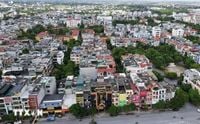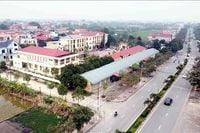The Vietnamese government is taking significant steps to streamline its administrative structure, particularly at the commune level, as part of an extensive reform initiative. The Ministry of Home Affairs is currently working on a proposal that aims to reorganize administrative units in 34 provinces and cities across the country. This ambitious plan is intended to improve efficiency and governance, while also addressing the surplus of public offices that has emerged following previous administrative adjustments.
On May 9, 2025, the Ministry submitted a detailed proposal to the Government, which includes a request for the authority to allow the Minister of Home Affairs to sign documents on behalf of the Government for submission to the National Assembly Standing Committee. This move is part of a broader strategy to streamline administrative processes and reduce bureaucratic complexities.
According to the proposal, the plan anticipates maintaining existing public secondary, primary, and preschool institutions, while transferring their management to local commune-level authorities. Additionally, vocational education centers and continuing education centers that are currently managed by district-level People's Committees are expected to be transferred to the Department of Education and Training for better regional service delivery.
The Ministry of Home Affairs has indicated that each province and city has developed specific plans for the arrangement, deployment, and investment in the repair and renovation of working headquarters to ensure adequate working conditions for agencies and organizations within the new administrative units. This is crucial as the country prepares to address the anticipated surplus of 4,226 public headquarters nationwide, a figure that has emerged from the rearrangement of provincial-level administrative units.
In Ho Chi Minh City, for example, a proposal has been made under Proposal No. 3019/DA-UBND to implement an urban government model that eliminates the need for People's Councils at the commune level. This model aims to enhance decision-making efficiency and governance in the bustling metropolis.
Prime Minister Pham Minh Chinh has emphasized the urgency of allocating funds to compensate individuals who may be affected by the restructuring, including those seeking retirement or facing redundancy as a result of the organizational changes.
In a related development, the Standing Committee of the Ca Mau Provincial Party Committee convened on the same day, May 9, 2025, to discuss three significant projects aimed at reorganizing the political system at the commune level. These include plans to terminate the operations of existing district and commune-level Party Committees and establish a new commune-level Party Committee directly under the Ca Mau Provincial Party Committee.
As part of this initiative, the Ca Mau Provincial Party Committee is expected to reduce the number of administrative units by approximately 60-70%, resulting in 39 commune-level administrative units from the current 100. This change reflects ongoing efforts to streamline governance and improve the efficiency of local administration.
The Provincial Party Committee has also outlined plans to reorganize socio-political organizations and mass organizations, which is anticipated to result in a significant reduction in administrative overhead. This includes reducing 5 out of 6 provincial-level units, 11 out of 20 room-level units, and 361 commune and ward-level units, leading to an overall reduction of approximately 229 staff positions across various levels of government.
These initiatives are part of a larger framework established by the National Assembly and the National Assembly Standing Committee, which aims to enhance the effectiveness of local governance and improve the delivery of services to citizens. The proposed restructuring is seen as a necessary step to adapt to the changing socio-economic landscape of the country.
In another significant development, a report released by the Ministry of Home Affairs highlighted that 23 provinces and cities have collaborated to develop project proposals for the rearrangement of 52 provincial-level administrative units. This comprehensive approach is aimed at ensuring that all newly formed administrative units meet the necessary standards set forth by the National Assembly.
After the proposed rearrangements, the country is expected to consist of 34 provinces and cities, including six centrally-run cities such as Hanoi, Ho Chi Minh City, and Da Nang. The staff positions assigned to the newly formed provinces and cities will total approximately 940,000, ensuring that the administrative framework is adequately staffed to meet the needs of the populace.
Furthermore, the Ministry of Home Affairs has stated that the total number of staff positions assigned to the 52 provinces and cities undergoing rearrangement will not exceed the total number of officials, civil servants, and public employees prior to the restructuring. This is part of a broader initiative to streamline staff positions while enhancing the quality of governance.
As these changes are implemented, the new provincial-level structures will establish People's Councils and People's Committees, which will oversee local governance. Each council will form various committees, including legal, economic-budget, and cultural-social committees, to address diverse local issues effectively.
In summary, the Vietnamese government's ongoing administrative reforms reflect a commitment to improving efficiency, reducing bureaucratic redundancy, and enhancing governance at all levels. As these changes take shape, they are expected to foster a more responsive and effective administrative framework that meets the evolving needs of the population.






